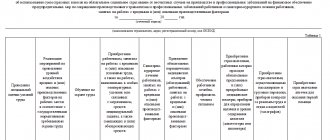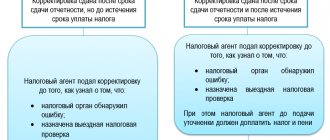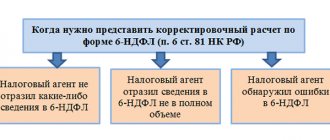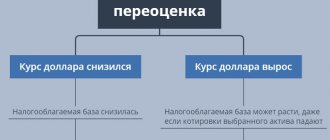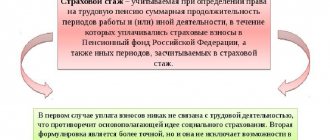Home / Taxes / What is VAT and when does it increase to 20 percent? / Declaration
Back
Published: 07/28/2017
Reading time: 5 min
0
275
The tax period for value added tax is provided for in Art. 163 Tax Code of the Russian Federation. This is a period of time (calendar code or other period) after which it is possible to determine the tax base and calculate the tax. Each tax has its own tax period, and it can combine reporting periods.
One quarter is the time of one tax period. If the enterprise was registered after January 1, the first day of its VAT tax period will coincide with the day of registration. In the event of liquidation or reorganization of an enterprise, the last tax period will coincide with the day of its liquidation (reorganization), that is, the day on which the dacha event was registered with the corresponding entry in the unified state register of legal entities.
In 2021, the VAT tax period is quarterly. In 2015, changes were approved in the Tax Code that relate to the deadlines for paying taxes to the state budget - unlike the old rules, the new ones provide for payment of the tax not on the 20th, but on the 25th. Payment must be completed within 3 months after the tax period by paying in each month in equal shares of 1/3 of the amount.
- Reporting period
- Tax period codes
What is the difference between a tax period and a reporting period?
The tax period is the time at the end of which the tax base is determined and the tax is calculated.
Each type of tax has its own tax period, and each of them can contain several reporting periods. The reporting period is the time at the end of which reports are compiled and submitted. In addition, a reporting period can also be established for taxes for which reporting is submitted only once per tax year, but during this year intermediate (advance) payments are calculated for them (for example, simplified tax system, land and transport taxes).
Read more about the tax and reporting period in this article.
Rules for drawing up and submitting reports
A declaration is a document that is a written statement by the payer about the objects of taxation, income and expenses, base and benefits, as well as the final calculated payment amount and other data that are the basis for the calculation and payment of the amount.
Documentation is provided to the tax authority for each type of fee that is required to be paid. During the reporting period, VAT is required to submit a declaration to organizations using the STS, as well as companies that combine SST and UTII. In addition, declarations must be submitted by organizations that issue invoices to buyers.
The tax period for VAT is set at three months, the reporting period for VAT has a similar period. The declaration is submitted at the place of registration of the company, payments go to the federal budget.
Document forms: tax period VAT
The declaration is submitted electronically. You can view the current version of the form through the official website of the Federal Tax Service. The title page should display the INN and KPP, data on the reporting year, and tax authority code.
The document contains information about OKVED, contact phone numbers, information about the taxpayer, his signature, and the date the document was drawn up. In the lower right corner, in a specially designated place, the data is filled in by a Federal Tax Service employee. After this, the user fills in the sections.
Tax period for VAT
The tax period for VAT is quarterly (Article 163 of the Tax Code of the Russian Federation). If the enterprise was registered after January 1, then the beginning of its VAT tax period will be considered the day of its registration (Clause 2 of Article 55 of the Tax Code of the Russian Federation). If the company was liquidated or reorganized, then the last tax period will be considered the day of its liquidation (reorganization), i.e., the day when the procedure was formalized by the corresponding entry in the Unified State Register of Legal Entities (clause 3 of Article 55 of the Tax Code of the Russian Federation).
See also: “How long is the tax period in the VAT return?”
Sales of goods (works, services) at a tax rate of 10 percent
Based on the possible VAT rates of 0, 10 and 18% indicated in Article 164 of the Tax Code of the Russian Federation, we can conclude that a rate of 10% is reduced and can be applied to those sectors of the national economy and production entities for which need to be stimulated to develop.
In accordance with the data specified in paragraph 2 of Article 164 of the Tax Code of the Russian Federation, a rate of 10% will be applied in the following situations:
- when selling food products (Resolution of the Government of the Russian Federation No. 908 of December 31, 2004). In this category you can find such products as agricultural products (poultry and livestock meat, dairy products, etc.), salt and sugar, cereals and pasta, fish products (with the exception of delicacies and exotic varieties of fish), vegetables, food food for children and diabetics, etc.;
- when selling goods for children (subclause 2, clause 2, article 164 of the Tax Code of the Russian Federation). The following goods are listed here: knitwear, clothing products (except for fur products and goods made of genuine leather), shoes (except for sports shoes), cribs and mattresses, toys, diapers, etc.;
- sale of printed products related to education, culture and science. However, it is worth noting that the reduced rate will not apply to periodicals, as well as publications related to erotic content. Also, those publications in which about 40% of the information relates to advertising will not fall into this category;
- goods for medical use (Government Decree No. 688 of September 15, 2008);
- sale of cattle, as well as breeding animals, their sperm and embryos;
- lease of breeding animals and birds with the right of subsequent purchase.
VAT reporting period
The VAT reporting period coincides with the tax period and is a quarter. This means that VAT reporting is prepared quarterly (that is, data is entered into the form not on an accrual basis, but separately for each quarter). In other words, the VAT return is submitted to the Federal Tax Service at the end of each quarter of the year and contains only data related to that specific quarter.
The deadline for filing VAT reports in 2020-2021 is no later than the 25th day of the month following the tax period (Clause 5, Article 174 of the Tax Code of the Russian Federation). This provision applies to both VAT taxpayers and tax agents for this tax.
The declaration must be submitted electronically.
Important! ConsultantPlus warns: An exception to this rule are some tax agents, as well as foreign organizations that pay the “Google tax.” If you are a tax agent, you can submit a VAT return on paper only if the following conditions are simultaneously met... For more details, see K+. Trial access to the system is free.
If the declaration is submitted on paper, it is considered unsubmitted. In this case, a fine will be charged for failure to submit a declaration (Article 119 of the Tax Code of the Russian Federation), and the account may also be blocked (clause 3 of Article 76 of the Tax Code of the Russian Federation).
Recommendations from ConsultantPlus experts will help you unblock your account. A free trial of full access to the legal system is available.
In addition to taxpayers, VAT returns are submitted (clause 5 of Article 174 of the Tax Code of the Russian Federation):
- tax agents who are not VAT payers or are exempt from performing duties related to the calculation and payment of VAT;
- enterprises that are not VAT payers, but have issued an invoice with the allocated VAT amount.
When liquidating or reorganizing an enterprise, it is better to coordinate the time for submitting VAT reports with the local tax authorities (clause 5 of Article 55 of the Tax Code of the Russian Federation). If there is no such agreement with the inspectors, then the declaration should be submitted within the prescribed period. But this must be done before the date of liquidation/reorganization, since after making an entry about this in the Unified State Register of Legal Entities, the enterprise no longer exists and there is no one to submit reports to.
Currently, the VAT declaration form and the procedure for filling it out are in force, which were approved by order of the Federal Tax Service of the Russian Federation dated October 29, 2014 No. ММВ-7-3 / [email protected] as amended. dated November 20, 2019. But with reporting for the 4th quarter of 2020, the form will be updated.
Read more about the rules for filling out the declaration:
- “What is the procedure for filling out a VAT return (example, instructions, rules)”;
- “Procedure for filling out the VAT return for the 3rd quarter of 2020.”
and in other articles in the section devoted to the VAT return.
Seller, be on the lookout!
If an organization determines the tax base for VAT “on payment”, then the moment of issuing the invoice for calculating the tax is not particularly important. VAT is accrued at the time of receipt of funds for shipped goods, work or services (subclause 2, clause 1, article 167 of the Tax Code of the Russian Federation). But for organizations working “on shipment”, the obligation to charge tax arises simultaneously with the shipment of goods, performance of work, provision of services, that is, with the presentation of payment documents (subclause 1, clause 1, article 167 of the Tax Code of the Russian Federation).
As we said, you can issue an invoice within five days after shipment. Therefore, the date of issue of the invoice and the day the tax is calculated do not always coincide.
This is where many accountants make the mistake of recording the invoice in the sales ledger on the day it is issued. And if the date of the invoice differs from the date of the payment documents and falls on a different tax period, then the VAT amount is included in the declaration for the next tax period.
